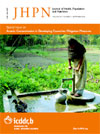
|
The Journal of Health, Population and Nutrition
icddr,b
ISSN: 1606-0997
EISSN: 1606-0997
Vol. 33, No. 2, 2015, pp. 1-9
|
 Bioline Code: hn15038
Bioline Code: hn15038
Full paper language: English
Document type: Research Article
Document available free of charge
|
|
|
The Journal of Health, Population and Nutrition, Vol. 33, No. 2, 2015, pp. 1-9
| en |
Dietary quality and patterns and non-communicable disease risk of an Indian community in KwaZulu-Natal, South Africa
Naicker, A.; Venter, C. S.; MacIntyre, U. E. & Ellis, S.
Abstract
Background: Limited data exist on the South African Indian diet despite their high prevalence of non-communicable
diseases. This study attempted to determine the dietary quality and patterns of an Indian population in KwaZulu-Natal
with reference to the high prevalence of non-communicable disease
Methods: Two-hundred-and-fifty apparently healthy Indians, aged 35–55 years participated in a cross-sectional study
where diet was assessed using a validated quantitative food frequency questionnaire. Mean intakes were compared to
the World Health Organization goals. Dietary quality was determined by index construction and dietary patterns by factor
analysis.
Results: The mean daily percentage of energy (%E) from n-3 fatty acids (0.24 %E), dietary fibre (18.4 g/day) and fruit
and vegetable intakes (229.4 g/day) were below the World Health Organization goals. Total fat (36.1 %E),
polyunsaturated fatty acids (11.8 %E), n-6 fatty acids (11 %E) and free sugars (12.5 %E) exceeded the goals. The means
for the deficient index reflected a moderate diet quality whereas, the excess index reflected good diet quality. The
Pearson partial correlation coefficients between the deficient index and risk markers were weak whilst, the excess index
was inversely correlated with waist circumference for the whole sample. Two factors were identified, based on the
percentage of fat that contributed to each food group: factor 1 (meat and fish versus legume and cereal pattern),
which accounted for added fat through food preparation; and Factor 2 (nuts and seeds versus sugars and visible fat
pattern), which accounted for obvious fat. The medians for waist circumference, blood glucose, cholesterol and
triglyceride levels showed significant decreasing trends for factor 1 (p < 0.05). The medians for blood glucose and
cholesterol showed significant decreasing trends for factor 2 (p < 0.01).
Conclusion: A shortfall of fruit and vegetable, fibre and n-3 fatty acid intake in the diet is highlighted. When assessing
the diet quality and patterns, guidance on the prudent use of added fats may lead to a healthier lifestyle reducing the
prevalence of non-communicable diseases.
Keywords
Diet quality; Diet patterns; Non-communicable diseases
|
| |
© Copyright 2015 - The Journal of Health, Population and Nutrition
Alternative site location: http://www.jhpn.net
|
|
